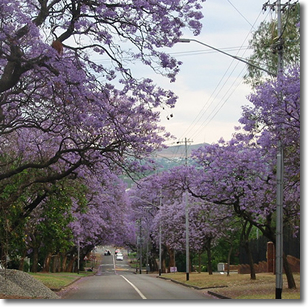Pretoria
 Pretoria is the official capital of South Africa and part of the Gauteng Metropolitan Province. It is in some ways twinned with Johannesburg, but is smaller, less commercial and certainly less frenetic in pace. It is here that the national administrative center, the Union Buildings are situated, as well as most of the international embassies and other administrative headquarters.
Pretoria is the official capital of South Africa and part of the Gauteng Metropolitan Province. It is in some ways twinned with Johannesburg, but is smaller, less commercial and certainly less frenetic in pace. It is here that the national administrative center, the Union Buildings are situated, as well as most of the international embassies and other administrative headquarters.
There has in recent years been a bit of naming battle surrounding Pretoria. Found by Voortrekker leader Marthinus Pretorius, there is a strong lobby among the liberationists to rename the city to better reflect the new South Africa, and no doubt to expunge any trace of an ugly past. There is an equally muscular lobby pushing for the retention of Afrikaner history as being as relevant as any other. Currently the compromise is that the city council is known as Tswane and the city nominally named Pretoria. For all intents and purposes, however, Pretoria is Pretoria.
The City
As African cities go, Pretoria is well preserved, with interest mainly focused on the many museums and monuments that track the phases of the city and nations growth. Some of the museums are quite arcane, for example the Correctional Services Museum and the Agricultural Museum, but others, such as the National Culture Museum, are more mainstream. Pretoria is also home to the State Theatre, a handful of nature reserves and gardens and the University of Pretoria and associated campus’.
There is a wide selection of accommodation options for all budgets, and in particular some of the nicer backpackers lodges in the region. It also enjoys a great nightlife and restaurant culture.
All in all Pretoria has a more cerebral overtone than Johannesburg, which is its richer, brasher and more edgy younger sister, but for those who want to tone down the electric buzz just a few degrees, Pretoria is the Gauteng base for you.
Climate
The city is situated about 30 miles north of Johannesburg, more or less on the point of transition between the highveld and bushveld north. It is gifted with a superb climate with mildl sunshine all year round and winters that ere never too cold, and summers never too hot. The city is awash with gardens and trees, in particular the lovely blue jacarandas that make their most magnificent displays in September, and is all in all a superbly pleasant place.
Summer temperatures range between 16°C at night to 30°C during the day. Winters are mild and dry with temperatures averaging between a minimum of 5°C and a maximum of 20°C.
When to Go
There is not particular time of the year that suits Pretoria, and each season enjoys its particular charm. The mild summer rains between late November and late February see the spectacular greening of the cities, with all the many gardens and suburbs exploding into color, while the autumnal shades of September are bless with the magnificent sprays of purple Jacaranda that cover the city.
Anytime is a good time.
Travel Warnings
Crime: Pretoria is not as dangerous as Johannesburg, but it is still a high crime region and no chances at any time should be taken in and around the city, the dangers of street crime and muggings are as high as anywhere else in South Africa. Don’t be fooled by the easygoing atmosphere. Keep your wits about you and remember that South Africa is one of the most dangerous countries in the world. There are certain areas in Pretoria that are more dangerous than others, although nowhere is particularly safe on the streets after dark, so seek and follow local advice on the matter of crime and general safety wherever and with whomever you go.
Leave important documents in a safe place. All hotels, lodges and hostels offer safe lock up facilities Seek safety advice from you hospitality establishment wherever you are Avoid walking anywhere after dark, particularly in urban areas, and particularly in the CBD of any of the larger cities and towns Don’t leave anything of value in your car overnight Incidences of car hijackings in South Africa are high Always be aware of your surroundings, particularly at night Don’t stop on any of the freeways for more than a few minutes, and in the instance of a breakdown, call for help
Health
AIDS: Any kind of casual sexual encounter in South Africa, as with anywhere in the world these days, is to be discouraged. South Africa has one of the highest infection rates on the planet, about 1 in 4 of the population, so obviously extra caution is necessary when visiting any destination on the sub-continent.
In most of South Africa tropical diseases are rare. While Pretoria enjoys a very mild, sub-tropical climate, incidences of malaria are rare, although there are occasionally a few mosquitoes about, and repellent is a must. As a matter of policy a course of anti-malarial drugs are advisable, particularly if you intend traveling further north up the coast.
Travel Doctor clinics are to be found in all the major centers where you can get health advice on malaria, yellow-fever, AIDS and any other tropical diseases, and acquire all the vaccinations and prophylactics necessary for your extended journey.
Tap water is usually safe to drink.
Sunburn risks are high so hats, long sleeved T-shirts and sun screen are a must.